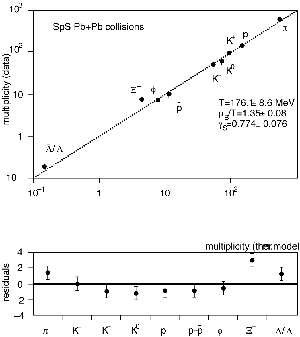
In the beginning there were quarks and gluons the “quarkgluon plasma”. Density and temperature decreased as the universe expanded and cooled. The quarks and gluons began to freeze, forming subnuclear particles (protons and neutrons). These in turn stuck together to form nuclei. So goes the dogma.
To check whether or not this is true, experiments at CERN hurl beams of high-energy nuclei at targets to create hot, dense fireballs of protons and neutrons. These may be hot and dense enough for the protons and neutrons to melt and their component quarks and gluons to be released from their nuclear habitat.
Experiments using beams of lead ions at CERN’s SPS synchrotron have recently polished their results. Included is the NA50 study, which is looking at the production of J/psi particles. These particles are composed of a heavy (charmed) quark and an antiquark, which are bound together. They are more difficult to form when quarks and antiquarks are less likely to stick together. A clear signal of J/psi suppression was, therefore, greeted as the first resynthesis of the quarkgluon plasma since the Big Bang. However, some physicists are pointing out that this is not the whole story.
In any plasma (a gas of charged particles) the charge carried by any one particle is screened by those surrounding it. This is called Debye shielding. Quarks and gluons interact via the tripartite colour charge rather than the familiar dual (positive/negative) electrical charge.
It is this screening mechanism that prevents quarks from sticking together above a certain critical temperature, T0, and beyond a certain energy density, E0. Subnuclear particles melt under these conditions.
However, the J/psi, as the lightest particle containing charmed quarks, is very small and tightly bound. Therefore it melts at a slightly higher temperature, about 1.3T0. This apparently small temperature shift is amplified for the energy density, which behaves as the fourth power of temperature. Thus J/psis melt at energies of around 3E0, which is much later than most subnuclear particles.
Furthermore, J/psis are special because their constituent charm quarkantiquark pair will never recombine once the plasma fireball expands and cools. They lose contact with each other and adhere instead to other, lighter quarks to form D mesons. Light quarks in the plasma will recombine into protons, kaons, pions, etc.
NA50 sees the onset of J/psi disappearance in the most violent “head-on” collisions of lead ions (and only lead ions) at maximum SPS energy (158 GeV per nucleon). The energy density, therefore, must have reached about 3E0 in these collisions. Other experiments using lead ion beams, such as NA49, estimate from calorimetric measurements that the energy density achieved in these collisions is about 3 GeV per cubic fermi (1 fermi = 10-13 cm, which is the “diameter” of a proton). Tentatively combining these observations leads to the conclusion that the critical density, E0,is about 1 GeV per cubic fermi, which is in agreement with quarkgluon field theory calculations.
This can now be tested by the experiments using lead beams (NA44, NA49, WA89 and WA97). Reinhard Stock of Frankfurt points out that hadron production in these reactions can be reconciled with quarks and gluons combining at T0, which is near 180 MeV, and E0, which is near 1 GeV per cubic fermi.
Previous theoretical studies of the transition from a quarkgluon fireball to a subnuclear fireball by John Ellis of CERN and Klaus Kinder-Geiger (who died in last year’s Swissair plane crash) had set the stage. Their model set out to explain how different subnuclear particles containing quarks and gluons emerged from electronpositron annhilations.
They showed that the transition probability depends on statistical mechanics, so that the relative production levels of different subnuclear particles infers the temperature prevailing at their birth. This happens as the initial high-energy density quarkgluon fireball expands and cools towards the critical temperature at which the particles crystallize.
Thus, experiments with high-energy nuclear beams are recharting the Big Bang.





